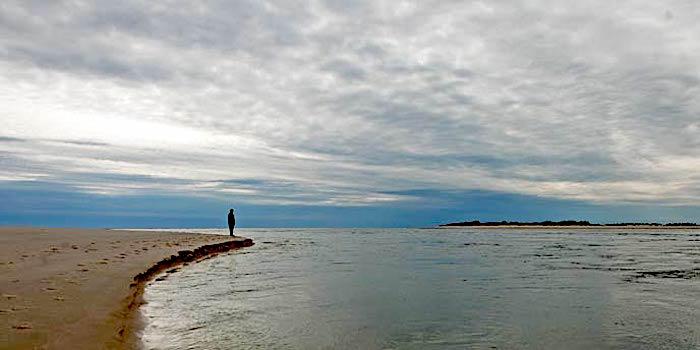
Fire Island National Seashore officials are discussing how best to manage a breach in the seashore created by Hurricane Sandy back in 2012/NPS
A breach in Fire Island National Seashore's coastline is a reminder of Hurricane Sandy. While two other breaches caused by the potent storm were filled mechanically, this one that lies within the seashore's Otis Pike Fire Island High Dune Wilderness Area remains, and seashore officials are debating how best to manage it going forward.
Barrier islands are creatures of the seas, cast about and pushed around by the waves and currents. Proof of that can be found at Fire Island National Seashore along the New York coast, where the barrier island it sets on was cut in two as well as shaved a little narrower in places by Hurricane Sandy back in October 2012.
In most cases at the national seashore, breaches are filled back in under the guidelines of the seashore's Breach Contingency Management Plan. That's how the breach at Smith Point County Park, which lies within the seashore's boundaries and also was created by Sandy, was quickly repaired. But the breach in the wilderness area has simply been watched.
Due to its location in the Otis Pike Wilderness, the breach is not disrupting any activities other than perhaps long walks along the beach. That's not the case when Cape Hatteras National Seashore in North Carolina is breached by storms. In 2011, Hurricane Irene breached the barrier island and took out Highway 12, the two-lane highway that runs down the heart of the island and to Cape Hatteras National Seashore.
Nevertheless, Fire Island officials are developing a Breach Management Plan and Environmental Impact Statement for the breach. Public comments will be accepted through October 8 on the NPS Planning Environment and Public Comment (PEPC) website.
The purpose of the Plan/EIS is to determine how best to manage the breach. The planning process will include opportunities for public input as well as consultation with federal, state, and local agencies with a regulatory interest or special expertise related to proposed actions.
As the NPS undertakes the Plan/EIS there are currently no plans to close the Otis Pike breach.
"The potential benefits and consequences of all possible alternatives must be thoroughly evaluated before a decision whether or not to close the breach can be made" said seashore Superintendent Chris Soller.
When the draft plan is released, it will include the Park Service's preferred alternative. The desired outcome of the Plan/ EIS is to ensure the continued integrity of the natural and cultural features of the seashore and its surrounding ecosystems while protecting human life and managing the risk of economic and physical damage to surrounding areas, the park staff wrote in a release.
Since Hurricane Sandy, the Park Service has worked with partners to monitor the breach. The breach has been relatively stable but not static. Its western shoreline has migrated and, as of July 1, 2015, the width of the breach along the ocean is 2,581 feet and 813 feet along the Great South Bay. Information collected in the bay indicates that the height of high tide has not changed significantly and the timing of high tide in the bay near the breach has shifted by approximately 20 minutes.



Comments
let it be mother nature is best at managing the earth and the needs for future generations.
Only a Fool would try to manage Mother Nature. !
thank you, keeping the breach seems to be a great idea the bay is definitely cleaner